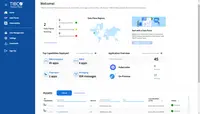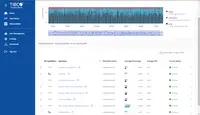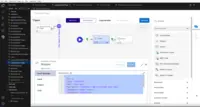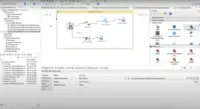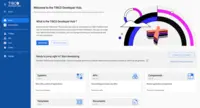TIBCO Integration (including BusinessWorks and Flogo)
Overview
What is TIBCO Integration (including BusinessWorks and Flogo)?
TIBCO Integration is used to connect diverse business solutions, data sources, and devices into a single, seamless system.
Broaden your horizon with Scribe
The Best integration tool in the world.
A good project accelerator
Could be better, does some of the jobs, but gets frustrating for API calls. Documentation is also too generic and they need recipes.
Stay tuned on data with TIBCO Businessworks!
TIBCO BUSINESSWORKS - More than just an Integration tool
Scribe Integration to Microsoft Dynamics GP
TIBCO Cloud Integration (including BusinessWorks and Scribe) at a glance!
Trust My Review
TIBCO Cloud Integration (including BusinessWorks and Scribe) is great!
TIBCO and Sales Order Process.
Empowering Seamless Integration with TIBCO Cloud Integration's Versatility and Performance
Seamless integration made easy
Reasons to use TCI
Awards
Products that are considered exceptional by their customers based on a variety of criteria win TrustRadius awards. Learn more about the types of TrustRadius awards to make the best purchase decision. More about TrustRadius Awards
Popular Features
- Pre-built connectors (120)7.575%
- Support for real-time and batch integration (117)7.070%
- Monitoring console (120)6.969%
- Connector modification (8)5.555%
Reviewer Pros & Cons
Pricing
What is TIBCO Integration (including BusinessWorks and Flogo)?
TIBCO Integration is used to connect diverse business solutions, data sources, and devices into a single, seamless system.
Entry-level set up fee?
- Setup fee optional
Offerings
- Free Trial
- Free/Freemium Version
- Premium Consulting/Integration Services
Would you like us to let the vendor know that you want pricing?
Alternatives Pricing
What is Azure Logic Apps?
Microsoft offers the Azure Logic Apps as a cloud-based integration service, supporting data and application integration.
What is SAP Integration Suite?
SAP Integration Suite is an integration platform-as-a-service (iPaaS) that helps quickly integrate on-premises and cloud-based processes, services, applications, events, and data. It is used to accelerate innovation, automate more processes, and realize a faster time to value.
Features
Cloud Data Integration
Cloud data integration software simplifies the task of integrating data from multiple different cloud applications
- 7.5Pre-built connectors(120) Ratings
Pre-built, tested connectors to a wide variety of applications such as ERP, CRM, HCM, Marketing Automation, etc.
- 5.5Connector modification(8) Ratings
Provision for modification of pre-built connectors to suit specific environments
- 7Support for real-time and batch integration(117) Ratings
Software supports both real-time and batch integrations
- 5.5Data quality services(6) Ratings
Software includes capability to perform data profiling, deduplication, cleansing etc.
- 2.7Data security features(7) Ratings
Data security features include rights management, LDAP integration, password encryption, etc.
- 6.9Monitoring console(120) Ratings
Central console for monitoring resource utilization, system health, ability to start and stop processes, etc.
Product Details
- About
- Integrations
- Competitors
- Tech Details
- Downloadables
- FAQs
What is TIBCO Integration (including BusinessWorks and Flogo)?
TIBCO Integration is used to connect diverse business solutions, data sources, and devices into a single, seamless system. TIBCO accelerates connectivity initiatives with low and no-code experiences engineered to reduce development time and costs. Users can implement the best-fit style of integration to address any app, data, IoT, B2B and mobile/web integration use case. TIBCO Integration can connect to virtually any endpoint across the IT ecosystem with 200+ pre-built connectors for a wide variety of business suites, databases and legacy technologies.
TIBCO Integration (including BusinessWorks and Flogo) Features
Cloud Data Integration Features
- Supported: Pre-built connectors
- Supported: Support for real-time and batch integration
- Supported: Monitoring console
Additional Features
- Supported: No-code Business Process Automation
- Supported: No-code Graphical Designer
- Supported: Container and PaaS Support
- Supported: Enterprise Scale
TIBCO Integration (including BusinessWorks and Flogo) Screenshots
TIBCO Integration (including BusinessWorks and Flogo) Integrations
- Salesforce Sales Cloud
- HubSpot Marketing Hub
- Microsoft SQL Server
- Adobe Marketo Engage
- Microsoft Dynamics GP
- SAP ERP, ECC
- MySQL
- NetSuite ERP
- PostgreSQL
- Salesforce Marketing Cloud
- ServiceNow IT Service Management
- Shopify
- Google Analytics
- Jira Software
- Sage Intacct
- ON24
- Oracle Marketing
- Oracle Database (legacy)
- Sugar Sell (SugarCRM)
- Microsoft Dynamics 365 Business Central
- Microsoft Dynamics 365
- Microsoft Dynamics AX, discontinued
- Adobe Commerce (Magento Commerce)
TIBCO Integration (including BusinessWorks and Flogo) Competitors
TIBCO Integration (including BusinessWorks and Flogo) Technical Details
| Deployment Types | On-premise, Software as a Service (SaaS), Cloud, or Web-Based |
|---|---|
| Operating Systems | Windows, Linux, Mac |
| Mobile Application | No |
| Supported Countries | Global |
| Supported Languages | English |
TIBCO Integration (including BusinessWorks and Flogo) Downloadables
Frequently Asked Questions
Comparisons
Compare with
Reviews and Ratings
(502)Attribute Ratings
- 1Likelihood to Renew28 ratings
- 8.9Availability6 ratings
- 7.2Performance6 ratings
- 4.5Usability23 ratings
- 7.3Support Rating28 ratings
- 5.6Online Training3 ratings
- 1.3In-Person Training5 ratings
- 10Implementation Rating8 ratings
- 7.3Configurability5 ratings
- 7.8Product Scalability23 ratings
- 7.3Ease of integration21 ratings
- 7.3Vendor pre-sale4 ratings
- 7.3Vendor post-sale6 ratings
Reviews
(51-75 of 235)A lot of potential, but it's got a long way to go
- Scribe has a lot of connectors for different types of sources and targets
- Security is easy to maintain in Scribe
- Scribe's use of graphical mapping designer makes it easy to visualize what a map is doing
- List view filtering is annoying in the interface. It does not save your filter or page that you were viewing. So if you click on a solution and then return to the list, the view is reset. You also cannot filter on solution status.
- Often the metadata for sources and targets do not display in mappings. Sometimes you have to close and reopen a map several times before the fields will display. It's extremely slow.
- There is no way to stop run-away processes via the application. I've had many instances where a process has been hung and cannot be stopped without calling in a ticket. Usually, it perpetually stay s in that state and you end up needing to recreate the solution.
- There is no way to purge the internal database file used on the Scribe agent. Once it reaches a maximum size (which is small), the agent becomes unusable and needs to be retired.
- It's difficult to manage which solutions are using which agents and which solutions are using which connections. There should be easier ways to report on this information.
- Often your changes appear to have been saved but are actually not saved and the solution does not run correctly.
- I've had instances where a source Oracle view is inputting x number of records but Scribe does not process them and does not produce any sort of error. It just looks as if there was nothing to process. This happens randomly.
- The "statistics" produced by the solutions do not make it easy to understand which maps produced which update/create counts. Also, the record counts are difficult to interpret and also thrown off by batching. Other cloud services seem to be able to produce easy to read record counts by step even when they include batching. Not sure why this cannot.
- There is no good instruction for determining the correct number of maps per solution or number of agents per server that are recommended.
- There is no facility for running pre and post processing commands (like in other similiar apps). So you cannot have a script to check for presence of a file or to delete a file or create a trigger file.
- Flat file handling is not very powerful and is clunky. If you want to change the delimiter used by a source or target file, you need to manually recreate the entire definition. You can import from a sample file, but the individual field type and sizes are lost.
- If you want to reassign a connection for a solution (like UAT to PROD), you need to go into each individual map and change the source there instead of being able to do it at the solution level.
- There is no way to copy a solution. You can have to export all the maps individually, create a new solution and then import all those maps. Then go into each one and wait for the metadata to refresh and then save each one (sometime several times) in order for it to become "complete".
- The progress counter is very slow to update on running solutions
- When a solution is running, there is no way to tell which map is currently executing within the solution.
- If you run an individual step within a solution instead of the entire solution, there is no way to tell which step is running until it's done.
- Validation within a map is cloogy. the slowness of the interface causes lag in the map validation. this flags errors that no longer exist.
- Mapping fields could be easier. there is no marker on the source side to show which fields have been mapped and which haven't. This is a pain when you have hundreds of fields to map. Other similar apps show a check mark.
- There are so many little things that could be improved about the user interface. I could go on and on.
Because of the diverse connector types available, Scribe is useful for accessing a variety of source/target types.
Tibco BW is relatively a very good product for implementing the Enterprise/Corporate level backend data processing
- The main strength of Tibco BusinessWorks is the seamless integration of development/testing/deployment.
- The learning curve of Tibco BusinessWorks Designer is not so steep, which helps to achieve a quick to the market strategy.
- The many levels configuration overriding possibility makes the solution flexible.
- The RESTful + JSON support is still not too perfect.
- The integration with the native self-developed Java modules is still lacking general framework support.
- It's too flexible to override the configuration properties on domain/engine/process/server levels and sometimes causes project management and maintenance problems.
Very good performances and high stability of the infrastructure
- We strongly appreciate the stability of our infrastructure. Issues do appear not frequently at all.
- It is easy to discuss with TIBCO designers/development teams and infrastructure teams.
- Fixes and new versions are frequently provided.
- TIBCO support is not good and does not answer in good times when we have issues. They often try to win some time while we are in trouble!
- We strongly regret that Tibco BW6 changed too many things regarding the administration and deployment of BW instances.
- Easy to implement and customize.
- The solution is fully integrated between SugarCRM and WCA.
- Fast and easy to debug.
- The placement of the GUI interfaces can be confusing.
- I'd rather have a split window screen (menu left and edit right) when editing a block property.
Good software for integration improvement
- The graphical interface allows zero code.
- Easy to use - allows custom interfaces to be generated quickly.
- Does not require developers to learn a new language.
- Licensing cost is significant.
- Some performance issues with UI.
Scribe your integration for success!
- Scribe allows integration to our CRM and Marketo.
- Having partners that know the solution very well and who are very informative.
- Having agents for on-prem is very helpful.
- There are some issues with different browsers that could be improved.
- More details on the error messages, so that they are actually helpful to end users.
- More logging/reporting options.
TIBCO Cloud Integrations
- Multiple connection options, as well as customization of your own connectors.
- Allowed for connecting to various systems, even a client's old legacy COBAL based system.
- REST and allowance to create custom connections, allowed us to close several client deals.
- Training for custom connector building is limited.
- If you are not a developer, learning to create custom connections is something you may have to outsource; it has a very steep learning curve.
- Some of the basic connectors (i.e. MS Dynamics GP) are a bit more limited than the on-premise version for Scribe Insight.
Best in the Industry
- Less time to develop and deploy
- Ease of maintenance
- Easy business integration
- Cloud integration is not well explored
- Restful JSON is not fully supported
- Version 6 is unfinished
TIBCO Cloud Scribe Insight Review
- Dynamics CRM integration
- GP adapter
- Ability to connect to multiple sources
- UI is not very intuitive
- Advanced formulas
A land of TIBCO Masters
- Tibco EMS is a very fast and robust solution to assist in processing a huge number of messages and guaranteeing a very high throughput.
- Ease of deploying a Tibco BusinessWorks project from development to production. It is almost zero deployment time.
- BusinessWorks designer is easy and intuitive to use.
- low code platform and therefore much reduced time to market
- TIBCO has a very strong innovation wing together with strong presence in the market
- With Tibco container edition,we can easily build cloud native integrations and take advantage of micro service architecture
- SFTP - currently TIBCO has no palette for performing SFTP operations. We have to write custom Java code which does the SFTP operations and then call the Java code from TIBCO.
- provision for a palette for performing smpp connections
Less Appropriate scenarios:
- Calling a target service which has no properly defined soap action and has generic schema APIs- this requires a lot of XSLT transformation and calling the target API using send HTTP request palette.This is quite complex and requires quite some skill in Tibco and may not be achieved by a junior developer
Scribe Review
- Integrates MS CRM and IBM
- We can have more customization
Impact of Scribe to Our Business Users
- Very easy for the sales team to use. All it takes is a quick CSV upload and running the solution.
- Errors are pretty easy to troubleshoot with scribe's error report.
- It's easy to set up and build new connections and solutions.
- Ability to easily add a unique identifier to every 'batch' of records created.
- Easy way to set up a workaround when the Cloud agent is down.
- The app could be more responsive (css/html).
Scribe Online Insights
- Easy to configure data migration maps
- Overview of failed imported records
- Fast Support
- More detailed error messages
- Migration performance speed
TIBCO Cloud Integration Review
- Real-time integrations.
- Dynamics CRM integrations.
- Salesforce integrations.
- SQL integrations.
- Page navigation.
- Some times export of solution fails with no detail error message.
- Easy to use drag-and-drop integration design and testing in Scribe Online.
- Clear and visual indications of integration errors or failures.
- Best suited for one-off data migrations or high-volume complex integrations that could be broken into smaller chunks. Otherwise, speed suffers.
- It's not yet able to handle API to API integrations with ease.
- Scribe Labs documents our ETL work in a very concise manner.
- The User Interface has a nice-looking design.
- We can export files to Dropbox.
- Installing the agent is a quick and easy process for on-premise.
- The Net Change feature is good.
- Missing functionality: We like to run all the files available in the FTP when clicking the run button. Right now, we have to click the run button several times (or have multiple solutions) in order to run files from our FTP site one at a time.
- Generating column fields every time a file changes from the source in the FTP is very tedious. Working in integrations makes me have to go back and forth a lot of the time, and doing this is incredibly annoying.
- The security is horrendous. We installed an on-premise agent on the customer side, but we don't want them even touching the ETL tool at all. The only knowledge we are fine with knowing and being able to see is that they installed the agent, not the solutions themselves.
- Our company's connector would have to point to the dataset name rather than dataset ID. It was very frustrating because we change the dataset name a lot, and then we'd have to repoint it.
- It's very difficult to monitor the different integrations that go on because there isn't a consolidated dashboard.
Not suited: Having many customers (being able to monitor them all effectively). Wanting a lot of customization. Wanting a lot of security. Wanting to minimize the amount of time it takes to go back and forth on integration solutions.
TIBCO Cloud Integration Review
- If you have MS Dynamics CRM, its a treat to have Scribe. It really helps a lot on moving data from and to CRM.
- SQL Integration is so easy with Scribe. It's on the cloud, it's fast and you'll be integrating just a couple of minutes.
- Flat file integration is seamless, it also manages post-processing such as moving the file somewhere else and renaming it so you know it has been processed.
- Third party connectors are not policed or tested properly. We have the SharePoint connector that has been difficult to get support and documentation and limitation are not in place. It would be nice to have TIBCO require proper standard documentation before allowing them in their marketplace.
- Scenario-based instruction is lacking.
- Not much tooltip in the app.
- Chat support directly from https://app.scribesoft.com would be nice to have.
Integrate Everything with TCI
TCI is a PAAS solution that helps customer to achieve important goals.
- Cloud solution (Paas).
- A simple method to implement agile solutions ensuring continuous integration.
- User-friendly implementation by using TIBCO Studio.
- Missing functionality: mutual authentication, missing of Oauth2.0.
- Missing monitoring of the performance of applications.
Easy to get up and running.
- Transfers data from server to server. This provides a consistent way to move data from server to server while keeping data integrity.
- Solid integration tools to help connect various data points.
- Error alerts to keep administrators aware of any issues that may come up.
- Real time data transformation between data points without writing code.
- More descriptive error tracking.
- Better documentation with Great Plains/AX integrations. Especially from the system administrator point of view.
- Well suited for large volume data transfer on a scheduled basis.
- Less appropriate for time sensitive data and relies on the response from the transaction.
- Easy to use visual mapping blocks
- Able to schedule nightly integration runs
- Lots of controls like "if Else" and "looping" that allow you to create complex data creation and manipulation
- Unlike Salesforce, Dynamics has more restrictions on updating closed records like Cases, Opptys, etc. It would be helpful if there were pre-created maps available that helped with the data manipulation steps required to update these records.
- It would be helpful to have better error messages. Sometimes it was very hard to troubleshoot failures.
- Faster manipulation of data would be better.
- Easy to configure connectors for almost any system you could use.
- Easy to use drag and drop UI.
- Quick setup. Sign up and be creating you first integration in minutes.
- See error details while a job is running so we can determine if we can let the job run or if it needs to be stopped.
- Templates for common integrations based on installed connectors
- Real time record integration.
- Migrating on premise Dynamics 365 to the cloud.
- Integrating ERP and CRM systems.
- Integrating any disconnected systems if a connector is available
Less Appropriate
- One off data dumps
- Small data sets (unless you're already a licensed user)
- Systems that do not have a connector
- The field auto-link feature is extremely helpful for migrations. This allows users to save an incredible amount of time when their systems might have thousands of fields that need to be mapped.
- The UI when creating a mapping is very clear and easy to use. It took me about half an hour to learn how to set up mappings and link fields. This will allow more people to be able to use Scribe.
- The error logs for records that fail to transfer or migrate are very detailed. I appreciate that when a mapping runs, I can see exactly which records failed and why.
- The most detrimental missing functionality for me has been that Scribe Online cannot natively move Dynamics entityimage fields. We had to externally hire a resource to build an app for us instead of being able to use the Scribe instance we provisioned for our client.
- Under Execution History, I would love to see the name of my mappings. There is a lot of good detail in the Execution History list, but showing the mapping name would allow me to quickly at a glance see what mappings I've already run and which I haven't.
- I'd like to see it be a little easier to delete organizations. Having many clients with various organizations in Scribe, there are some orgs created by accident that I wasn't able to figure out how to remove without researching it.
Scribe Review
- Set it and forget it mentality for constant replication
- Warnings of system interruptions or other issues quickly identify problems
- Modifying solution on the fly easy via dashboard
- A couple lingering support issues not resolved after months, have stopped trying and now "live with it"
- Not much else; when it works, works fine. Sometimes variable speed in synchronizing is frustrating but usually doesn't last and not worth engaging
First time Scribe user!
- Data mart replication - easy to pull needed tables
- UI is intuitive and fairly easy to understand despite not having a technical background
- Support is slow, very unresponsive at times, takes way to long to respond
Love TIBCO!
- Fast - It only takes a few minutes for the data to be sent over to our other system
- User Friendly - Not hard to navigate or use
- Great Customer Service- Whenever we do have a problem they are quick to address the issue
- Notify us when updates are done. There was recently an update that affected our entire system and we were unaware. I had to reach out to our contact in order to find out.


